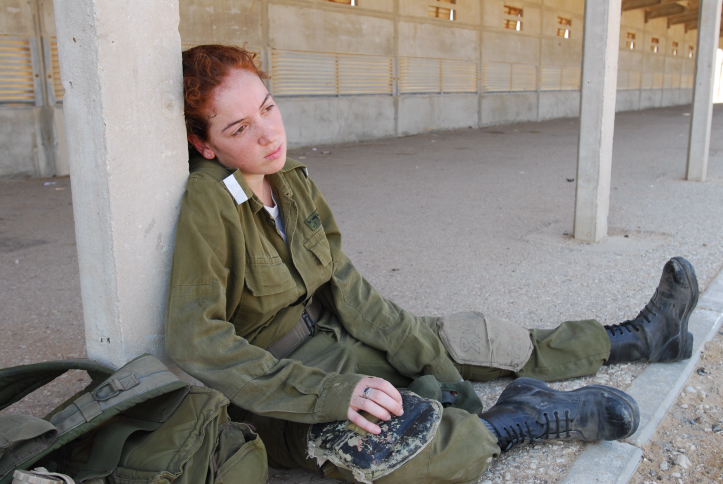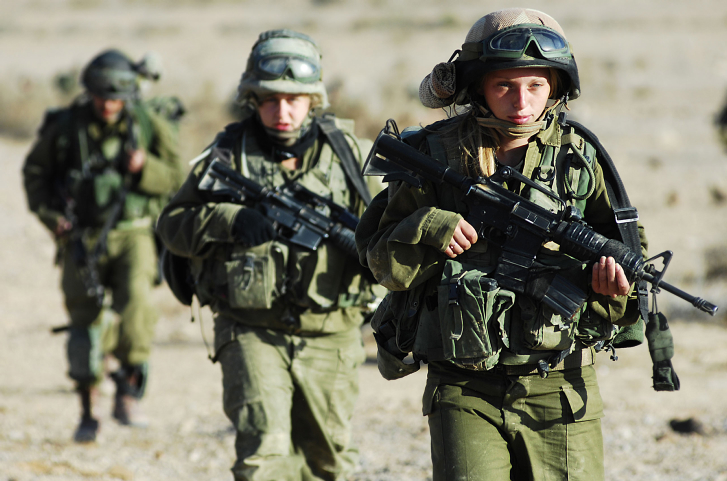Like it or not, nature is not egalitarian.
The past few years have seen a silent revolution in the IDF, where the pressure of radical groups have forced it to integrate women in combat formations • But is an army whose purpose is to endure heavy physical burdens in defense of the country equipped to recruit women in the name of gender equality? • Aside from the damage to the effectiveness of combat units and formations, the real victims are the women themselves, who suffer from a variety of serious injuries, including stress fractures, damaged uteruses and a variety of infections • Like it or not, nature is not egalitarian

An army's purpose is to fight and win wars. The purpose of the military profession is to drive its members towards the source of danger, charge and win. This is true for armies in peacetime, and all the moreso armies in areas of conflict. Therefore, changes in the army need to be examined first and foremost in terms of how they affect the army' ability to carry out its primary purpose.
The past few years have seen a global campaign to integrate women into combat units in the name of "gender equality." Israel is no different in leading the way to integrate women to satisfy the demands of radical egalitarian groups.
But have women increased or at least kept up the IDF's combat capability or have they brought it down? More importantly, what has happened to the women themselves?
A Bit of History
The change started in 1995, when the Supreme Court ruled that Alice Miller had to be allowed to take Air Force tests in the name of gender equality and in spite of the army's objections. Judges added the reservation that this was an experiment, which takes general readiness and capability into account.
In spite of the cautious language, this was a breach in the dam. Many combat positions were soon opened up to women, without even the token "experiment," quotas or even an organized integration timetable. These included sailor's courses, positions in the Air Force's anti-aircraft units, in the NBC (nuclear, biological, chemical) unit, the Engineering corps and the Border Guard. Eventually the IDF even established a light combat battalion known as 'Karakal' ['kravi kal' or light combat], in which men and women serve together patrolling peaceful borders.
A Crushing Failure
In spite of all the efforts to ease the acceptance of women into the air force, their success rate stands at only five percent, as opposed to twenty percent for men. Furthermore, the percentage of women entering the army who volunteer for combat positions is only two percent – and these only in relatively marginal and easy tasks compared to traditional combat roles.
Furthermore, as Captain Katie Petronio of the US Marine Corps said bluntly, the first to be harmed from this crusade are the women themselves. Take Ayelet Dressler, who told Avi Kefiri of Maariv:
I sat in the shower simply because I couldn't stand. It took me fifteen minutes to walk 100 meters. It started with relatively light stress fractures during basic training. My high motivation and sense of commitment made me move on and give as much of myself as I could. In spite of the good intentions, the problem got worse. Relatively light stress fractures in my leg developed into level 4 stress fractures, which is a very high level, in the soles of my feet, thighs and knees. It got to the point that I couldn't even really go to the bathroom. They let me rest and the staff was very considerate, but after a month and a half in basic I got to an orthopedic and I felt the doctors all thought we were just crybabies.
I had bone mapping done and was given a month and a half of medical leave. I went back to the unit, had physiotherapy once a week and continued to lie down in the tent. I was in the operations room some of the time, and every so often they tried to bring me up to combat readiness. It didn't work […] Today I suffer all the time from pains, and it doesn't matter if I walk, sit or sleep. If have pain in my lower back, my thighs, shins, and soles. My elbows, palms, back and shoulders also hurt. It doesn't leave me.

She isn't alone. A female soldier who preferred to remain anonymous, said that "I said that it hurts and they forced me to go on, and I say, I don't want to be crippled, and everyone pushes me, and I continued and I'm sorry I did; in retrospect I shouldn't have continued."
These testimonies and many others have backing in in-depth research. Between 2004 and 2009, the Institute for the Study of the Soldier's Health in the Military Physiology Unit conducted a study following male and female soldiers with the purpose of examining gender differences according to physiological-health measures over a six month period. The subject of study were the men and women from Karakal, which receives 03 rifleman training [01 being the easiest and 07 being the hardest]. These measures included physical aspects, nutrition and psychological condition.
311 soldiers were studied, including 226 female soldiers and 85 male soldiers from three different recruitment periods. Measures were taken on draft day, in the middle of basic training, at the end of basic training and a year after that. Against the female soldiers being examined, there were two control groups: 1) the male soldiers in Karakal 2) female soldiers working as medics or dental assistants. The study revealed that even after female soldiers were given an easier set of physical requirements than is standard in "male" combat units, 12 percent still suffered from stress fractures as opposed to 0% of the men. Meanwhile, men who served in Karakal achieved lower physical fitness than that generally required in the IDF.
In case you were wondering, the authors of the study recommended a reduction of 30% in physical requirements for female soldiers (of cardio-pulmonary exercise such as running), and limiting the weight a women can carry to 30% of her body weight as opposed to 40% for a male soldier.
The Female Body Just Isn't Up for the Job
The study was published in a number of reports, which don't require specialist background to understand. Women are generally shorter, weigh less, have smaller muscle mass and a higher fat percentage compared to men. These innate differences lead to differences in physical capabilities, and indeed men have been found to have higher oxygen consumption and greater aerobic and anaerobic endurance. Men have a stronger, sturdier and more durable outer physical shell for handling military training and activity.
There are also essential differences in skeletal structure: women's thigh and knee bones are shorter and narrower than men, and they are less durable. Because injuries are the army's primary concern due to their direct effect on soldiers' combat readiness, this is a matter of great concern. In the American army, skeletal damage became the most significant factor among injuries related to excessive activity, and stress fractures are considered the leading medical condition to negatively affect combat readiness (especially due to the long healing period).
The physiology of the female body – the skeleton, the height of the arch, the external rotation of the female thighs and pelvic bone, as well as the excessive pressure of fat on the skeleton and muscles – is simply not as appropriate for combat activity as its male counterpart. It's worth mentioning that a series of studies in this area find that using different fitting shoes – such as basketball shoes, military boots &c – has no significant effect on minimizing these injuries.
During military training, the differences between men and women in physical capabilities do shrink, but only in a limited manner insufficient to ensure combat readiness. More than that, during the experiment, it turned out that as opposed to men, women also suffer stress fractures just from an extended period of standing, not just running.

Sexuality and romantic connections harm cohesion
Aside from physiological differences, IDF studies "revealed" what the American and British armies already found at the beginning of the 2000's – when the IDF was beginning to integrate women. These studies revealed five primary problems regarding the service of female combat soldiers:
Physical damage. Female soldiers' relative unsuitability for the physical demands of combat tasks led to a very high rate of injuries – both in amount and severity – including slipped discs and shoulder infections relative to their male counterparts. A significant number of injuries were unique to women: stress fractures in the pelvic area, infections of the womb and pelvic organ prolapse.
Harm to operational combat readiness. A significant reduction of the bar for minimum physical fitness in units opened up to women, severely harming the unit's combat readiness and capability.
Cohesion. Unintentionally, the presence of women immediately changes the social chemistry among men, harming the cohesion which is the backbone of military units. The minute one soldier begins to act defensively, sexually or in a hostile manner, it creates a dynamic that drags others in. Thus is an adverse climate created that is contrary to the necessary cohesion for a military unit. This behavioral change leads to unnecessary competition, disunity and even the disintegration of the unit. The improved conditions often given to female soldiers are contrary to the idea of equality among soldiers and are a source of jealousy and anger among soldiers.
The Distraction of Sexual Tension. Sexuality among men and women, especially those aged 18-21, is a very powerful force. Sexual attraction, on both sides, exists and will continue to exist. Whether it is realized or not, it creates a significant distraction in the unit. Sexuality is the immediate threat, but love between two members in the unit can be even worse. Love changes loyalties; it creates stronger ties between certain members of the unit to the detriment of other loyalties within the unit – and there is no place for such preference in a unit.
Cost VS. Benefit. Integrating women into military units involve significant financial costs, including preparing special installations to provide them with privacy and appropriate conditions. But there is another cost involved: compensation to female soldiers harmed during service.

The above table breaks down complaints submitted to the Defense Ministry by male and female regular soldiers during 2010-2013. Female soldiers are only 2% of all combat soldiers, but they are on average 13% of those who file a complaint. In other words, women file suit on average six times more than men. Remember – this is when women are not serving in the core units of the army – infantry, special forces, armour and engineering – in which the physical fitness bar is far higher than in units which have accepted women. If this were the case, the amount of complaints would no doubt be much higher.
Leave feminism out of the army
Gender equality is important, and the struggle to achieve it in non-military fields is more than justified. But the heavy burden the IDF faces to ensure the security of its citizens and territory in a region filled with threats means it can only take one thing into consideration: efficiency. Anything unrelated to military efficiency and soldiers' combat readiness has to go.
As important as the feminist struggle is, it has nothing to do with the requirements of carrying heavy loads, storming positions, combat or long marches – all of which are required in combat.
Ideology cannot beat physiology.
Colonel (Res.) Raz Sagi is Chairman of the Forum for the IDF's Strength and the author of 'To be a Battalion Commander' and 'Women Fighting in the IDF' (Both in Hebrew), both of which have been recently published.
English translation by Avi Woolf.
To receive updates on new articles in English, join Mida on Facebook or Twitter or join our mailing list.





I am a 1981 graduate of the IDF Armored Corps Commander's Course. The IDF is very egalitarian but they are also very pragmatic. COL Sagi is absolutely correct in his analysis. It is common sense! However, political correctness abstains from common sense to push ideology. I highly recommend LtCol Robert Maginnis' (US Army, Retired) book, "Deadly Consequences" on this very topic.